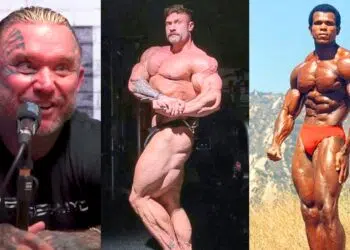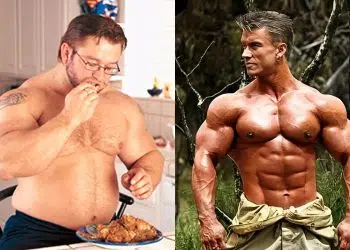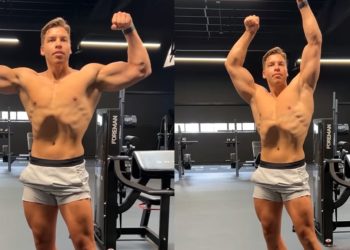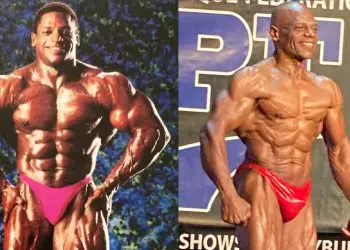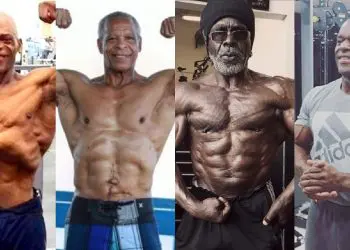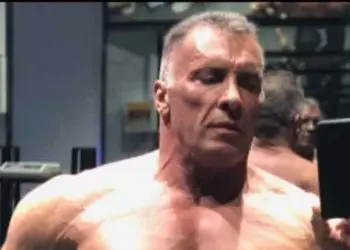The Way We Were: A Classic Bodybuilding Love Story
by Shawn Perine (A piece on classic bodybuilding Shawn wrote back in 2002 )
Nostalgia has a way of creeping up on the best of us.
When we’re young and headstrong (and don’t the two always go hand in hand?) we can conceive of little but what the future holds. Life is an unceasing race to move ahead of the quaint standards of yesterday. There are too many oats to be sown in the greener pastures of The Future to worry about The Past. Let the thirty-year-olds worry about it. At that age there isn’t much to look forward to anyway…
classic bodybuilding contest But then one day you find yourself sitting in the car, listening to the radio, and thinking, “What is this music? I remember when music was good…” Suddenly, you realize what’s happening: You’re getting nostalgic.
But forgetting about the blank stares you get from members of the younger generation, a sense of nostalgia can be a good thing. It helps you to appreciate museums and libraries, and the fact that everything that comes around goes around.
In fact, if it weren’t for the nostalgic feelings of so many of you, I’d have had little reason to put this site up in the first place. But sensing that I’m probably not alone in my longing for the “good ol’ days” of classic bodybuilding I took a chance and created it. And to my happy surprise, there are even more of you out there who feel the same than I had imagined.
Level Up Your Fitness: Join our 💪 strong community in Fitness Volt Newsletter. Get daily inspiration, expert-backed workouts, nutrition tips, the latest in strength sports, and the support you need to reach your goals. Subscribe for free!
So, with the confidence of one who speaks to an audience of simpaticos, I’d like to present my list of reasons as to why so many of us choose to remain nostalgic for the classic bodybuilding of old rather than join the fray of today’s participants.
Problem #1: “I WANT IT YESTERDAY!”
I’ve been involved in bodybuilding for two-thirds of my 36 years, which means I have a longer history with the sport than the current and four-time Mr. Olympia Ronnie Coleman. At 5’9″ and a fairly lean 180 pounds, with 17″ arms and 25″ thighs, I’m not small, but wouldn’t be mistaken for anything more than a local-level competitive amateur bodybuilder at best. I’ve pretty much reached my natural capacity for muscular size. After more than 20 years of training this is obvious. And while it may not sound like much, considering my bone structure (6-3/4″ wrists, 8-1/2″ ankles), I’m probably a solid 25-30 pounds heavier than I’d be if I didn’t lift at all.
I cite these mundane facts to illustrate a point. I’ve invested a good deal of my life in something I love: the pursuit of muscle growth. I’ve logged countless hours in the gym and counted countless grams of fats, carbs and proteins to make what are, admittedly, modest gains. But I earned every last ounce of my muscle mass, no matter how much it is. And, as cliche as this may sound, the path I took to get where I am today had a much more profound influence on the person I am than the muscles I carry on my frame. It’s the knowledge that I can will myself to withstand extreme physical duress and counter daunting challenges with perseverance that has given me a level of inner confidence I know I couldn’t have attained without experiencing bodybuilding the way I have.
And I am far from alone in having learning this lesson. Gyms used to be full of guys working tirelessly for hours at a time, days on end, desperately trying to eke out a few extra pounds of muscle a year, but relishing the struggle as much as the results themselves. It was what our forebears did and we patterned ourselves after them.
Original Golds Gym Bodybuilding
But sometime in the 1980’s a shift occurred. Whereas up until that time classic bodybuilding gyms were generally dark, dank, unhip places that kept most of the uninitiated out by virtue of nefarious repute, clean, user-friendly “health club” chains began sprouting everywhere in the mid-80’s. Gold’s, World, Equinox, Crunch, even independent gyms began to project a hipper, more inclusive image.
Concurrent to this, the classic bodybuilding look was becoming considerably more acceptable to the public thanks to the mainstream success of film stars Arnold Schwarzenegger, Sylvester Stallone and Jean-Claude Van Damme.
Finally, steroids, which were always available to those in the know, were finding a home in high school, and even junior high school, locker rooms. No longer was steroid use confined to serious athletes who, for the most part, had at least a cursory understanding of their pros and cons. Now “juice” was becoming a recreational drug, as easy to obtain as pot.
So, with these three factors– the proliferation of health clubs, the popularization of a muscular look, and the widespread availability of steroids– all peaking at around the same time, the stage was set for a revolution of sorts.
Suddenly, gyms were teeming with kids whose motivation for getting muscles stemmed from a desire to show their six pack on MTV or emulate a movie star or just show off to the girls who were training over on the next bench. Without a care for, or understanding of, the processes that go into building muscle, let alone an appreciation of the history of those who followed the same pursuit before them, they saved up their allowances to buy a few cycles of Anavar or Deca or Winnie and gained muscle, and an attitude, in record time.
Whereas in the insular environs of the old classic bodybuilding gyms youngsters were often advised by their seniors to “give it a few years” before going on the juice, now a significant number of kids were beginning their first cycle along with their first training routine. Some were even juicing without training at all. To them, only suckers would persist for years on end to make fewer gains in muscle mass that they could in a few months.
So, while it’s hard to say what the end result will be for all of these kids who were juicing when they should have been growing up, it certainly seems to signal the end of innocence (for lack of a better term) for many a bodybuilding purist.
Problem #2: BIGGER (and leaner) IS BETTER
In professional bodybuilding a quantum shift occurred in 1992 when Dorian Yates won his first Mr. Olympia title. Whereas Lee Haney, the winner of the previous eight Olympias, retained a classical look that harkened back to the days of Steve Reeves (although with greater muscle size), Dorian ushered in a new era in which mass superceded aesthetics to the point of making them nearly obsolete. And that era persists to this day.
Level Up Your Fitness: Join our 💪 strong community in Fitness Volt Newsletter. Get daily inspiration, expert-backed workouts, nutrition tips, the latest in strength sports, and the support you need to reach your goals. Subscribe for free!
In the early seventies proportioned mass ruled. Extreme definition did not.
Arnold Schwarzenegger, Dave Draper, Reg Park Even at the amateur level there are behemoth competitors with the mass of two Steve Reeves but devoid of aesthetic refinement. And with the proliferation of GH (Growth Hormone) use these days, even bodybuilders’ bellies are taking on monstrous proportions.
A couple of bodybuilders have found that even this isn’t enough and have resorted to injecting synthetic oils and oil-based compounds under their skin, which swells underneath like a water balloon, stretching the derma in directions previously unseen on the human form (with the possible exception of extreme cases of goiters and abscesses).
Added to this is the extreme use of diuretics by today’s top competitors. More dangerous than steroids, GH, and synthol combined, diuretics (used improperly) have claimed the lives of two pro’s and very nearly that of at least another. The look they render in the faces of their users is not unlike that of the subject of Edvard Munch’s painting “The Scream.”
While steroids have been a part of the game for about 50 years now, the progression from classic bodybuilding as being a sport enhanced by steroid use to one ruled by unfettered drug abuse has never been more dramatic than over the past ten years.
Problem #3: WHERE IS THE LOVE?
This problem is really an extension of Problem #1 but worthy of its own category because, while not so much a cause of the decline of bodybuilding, it is a byproduct of its decline that affects me most personally.
With all of the showoffs and scenesters bodybuilding has attracted the overall vibe of the gym environment has been altered dramatically.
When I was sixteen I joined my first gym, Mr. America’s. Owned by the legendary hardcore bodybuilder Steve Michalik, it was one of the most serious, bare-bones gyms to be found anywhere. And yet, despite its appearance and reputation, it was one of the most comforting places I’ve ever known. Once the older guys there recognized my earnestness and determination they welcomed me into their fraternity with open 19″ arms. On Sunday mornings the gym was our church and it was mostly of the Baptist kind. In essence, we were one big choir preaching the gospel of iron. The energy was unbelievably positive. Workout partners interchanged frequently. Everyone was everyone else’s spotter. We all had a common goal and almost as much desire to help each other reach it as we did ourselves.
I rushed to finish my homework weeknights and forced myself to wake early on weekends to get to that gym. Not only to train but to be there.
A few Mr. America-type gyms exist today; gyms that are not only great gyms, but which have that magical feel as well. Bev Francis’ Gold’s gym on Long Island comes closest to embracing that old feeling for me now. But they are a rare breed these days.
For the most part I find today’s gyms (Oops, I mean “health clubs”) to be a mix of aggressive, loud, and generally unpleasant guys with big arms and shoulders who see it as their charge to intimidate those smaller than them, and unmotivated, clueless people who are there either because it mollifies their guilty conciences or because it gives them something to talk about at the water cooler. And then there might be a few old-timers like you and I who appear as fish out of water to the others, with our steely determination and exotic-looking exercises.
So Where Do We Go From Here?
As I watched the sun set on classic bodybuilding I knew and loved I railed against the dying light with all my strength only to watch it change anyway. And now, with a new day dawning for the sport, I feel compelled to ask myself if it is really somehow diminished from what it was back when most of the today’s competitors were in diapers?
Maybe. Maybe not.
The popularization of bodybuilding has, in reality, helped far more than hurt it as far as bringing money to the professional competitors and educating the public as to what bodybuilding is and what it isn’t.
The increased drug use was an inevitability once it began in the first place. But one result of the drug-related mishaps that have occurred is a crystal-clear realization by all bodybuilders of the actual dangers of drug misuse as well as a surge in the popularity of “natural” contests.
And while gyms are no longer the domain of just muscle heads, their new, inclusive image has given millions of people the chance to utilize them in an effort to live longer, healthier lives.
So, in the end, as always, the past was the past and the present is the present and, in reality, I suppose neither is better or worse than the other. It’s just the tint of the glasses you’re wearing when you’re reflecting on each that matters.
But that doesn’t mean that there’s anything wrong with getting a little nostalgic now and again.
*With classic bodybuilding still always on his mind, Shawn Perine is the Senior Writer for Flex Magazine.


